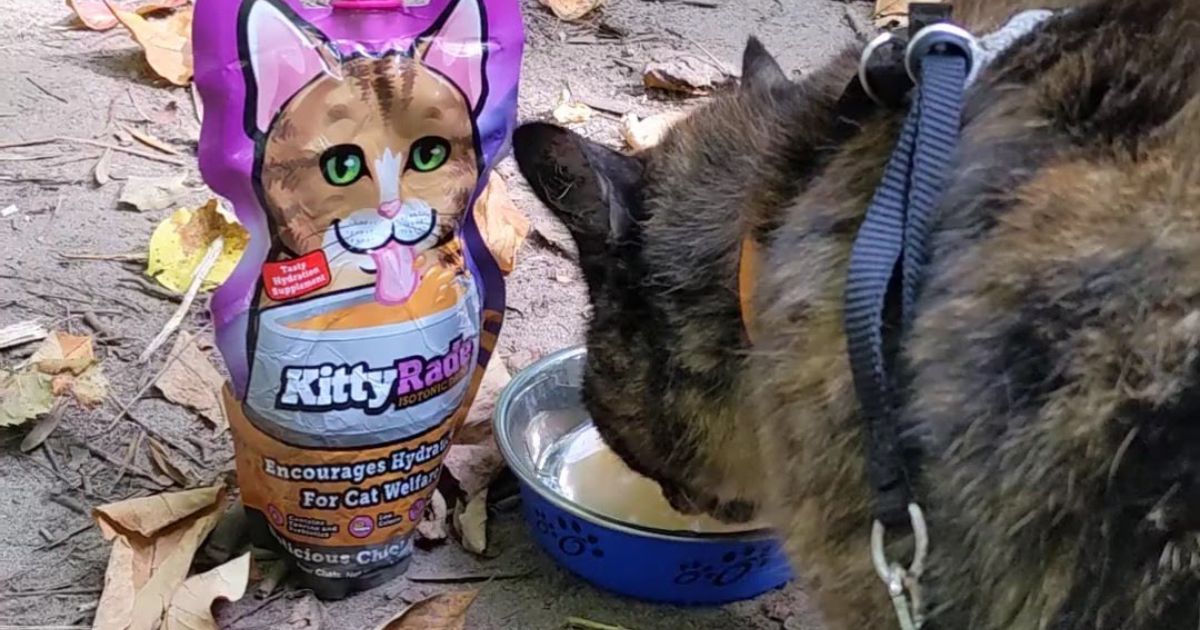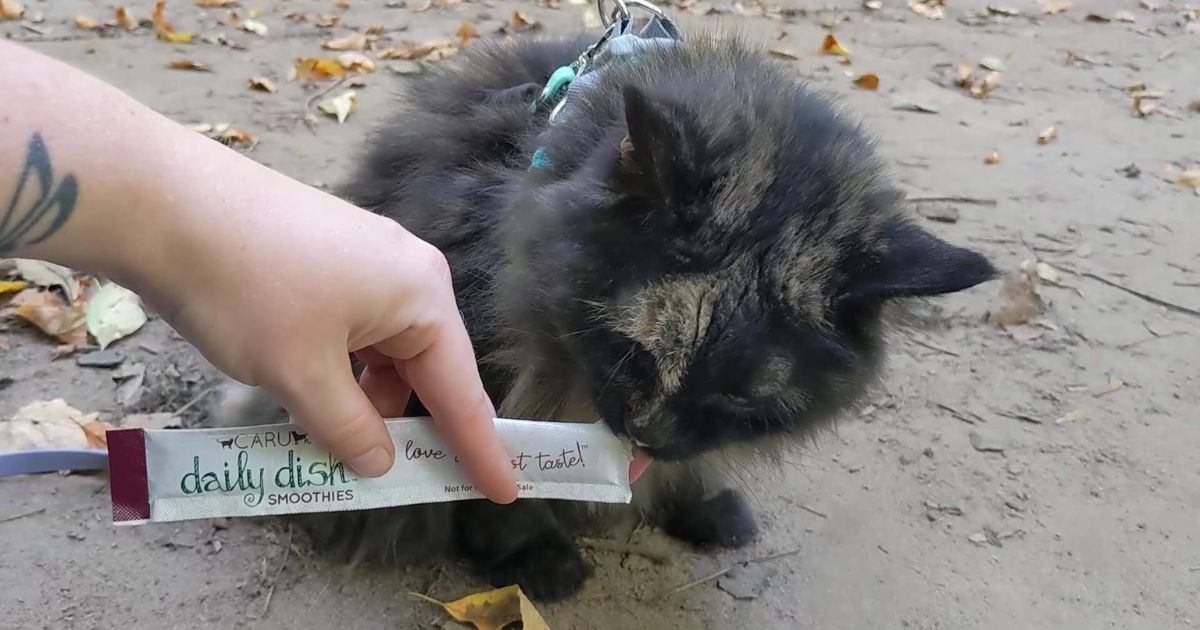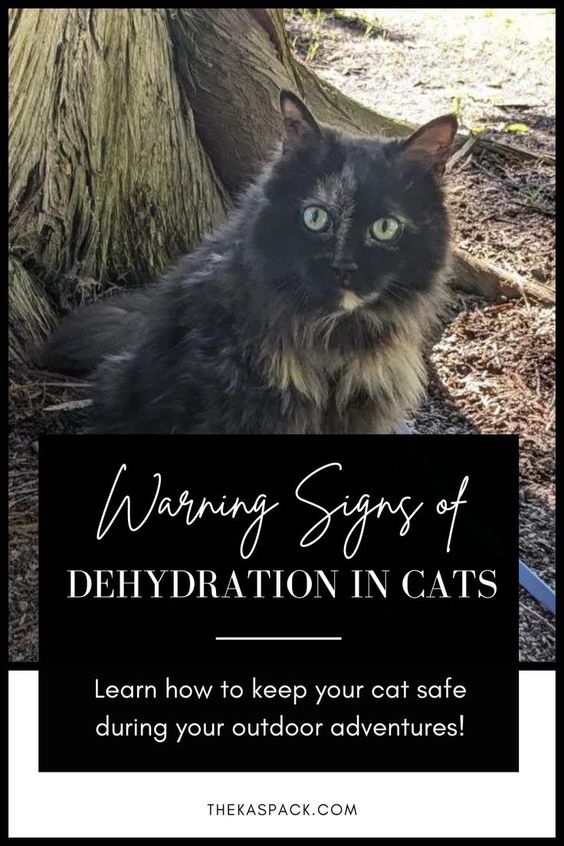8 Warning Signs of Dehydration in Cats
We often talk about the importance of carrying enough water to hike safely, but we aren’t the only ones that need to be properly hydrated when adventuring outdoors.
Today, we’re going to dig into the risks of dehydration in cats including the warning signs to watch for, what to do if your cat is dehydrated, and how to prevent dehydration when you’re exploring together.

This post contains affiliate links, which means if you click and buy, we will make a commission (at no cost to you). See my full disclosure policy for more details.
How Often Should a Cat Drink Water?
Before we get into an explanation of what causes dehydration in cats and how you can prevent it, you first need to understand your cat’s hydration needs. This means recognizing how much water a healthy cat should be drinking as well as being familiar with how your travel plans can impact these needs.
A healthy adult cat needs 1 cup of water for every 10 pounds of lean body weight each day. This includes drinking plain water as well as consuming water in other forms like food or treats.
What Causes Dehydration in Cats?
For outdoor travellers, the causes of dehydration that you should be most aware of include not drinking enough water, high activity levels, and spending too much time outdoors in the heat of summer. In fact, most cases include a combination of these risk factors.
Outside of the travel-related risks, there are many medical explanations for the development of dehydration in cats. This includes diseases or medical conditions that either prevent your cat from drinking enough water or cause an increased level of water loss. This includes:
- Vomiting
- Diarrhea
- Diabetes
- Kidney Disease
- Hyperthyroidism
- Dental problems
- Side Effects of Medications
If you suspect that your cat’s hydration problems are related to a medical cause, contact your veterinarian. The only way to make it safe to adventure with your cat is to first address this underlying problem.
Signs of Dehydration in Cats
It can be difficult to identify whether your cat is drinking enough water to meet their hydration needs. Especially if you aren’t supervising their every move 24 hours a day. Luckily, that isn’t the only way to recognize that something is wrong.
The most common signs of dehydration in cats include:
- Dry or sticky gums
- Loss of appetite
- Constipation
- Sunken eyes
- Loss of skin elasticity
- Increased heart rate
- Lethargy or lack of energy
- Depression
To check your cat’s skin elasticity, carefully pinch the skin over the shoulders and lift it up. Watch how long it takes for the skin to return to its normal position. This should happen almost instantly in a healthy adult cat. If it takes longer, this is a warning that your cat may be dehydrated.
As cats enter their senior years, many cats will naturally lose skin elasticity even when they are properly hydrated. For this reason, the skin test isn’t as accurate in a senior cat.
If you notice any of these signs that your cat may be dehydrated, contact your veterinarian as soon as possible.

Treating Dehydration in Cats
If your cat is dehydrated, you should speak with a veterinarian. While we don’t recommend treating dehydration in cats yourself without medical care, there are steps that you can take to help hydrate your cat in the meantime. This is especially important if you are adventuring a significant distance from the nearest vet or emergency clinic, such as backcountry camping.
Here are a few options that could help to address your cat’s hydration needs quickly and effectively.
Can I Give My Cat Gatorade?
A small portion of Gatorade isn’t going to hurt your cat, but it’s not the best option for your cat unless you are stuck with no other solution available. Created specifically for humans, the levels of sugar and sodium in Gatorade are too high for a cat to enjoy safely.
If you are concerned about having an electrolyte drink on hand, there is a product made specifically for cats called KittyRade. Not only is this a great option for boosting your cat’s hydration, but it’s also packed with other nutritional benefits such as natural prebiotics, and essential amino acids including taurine.
Can I Put Pedialyte in My Cat’s Water?
Another solution that we use for human dehydration is Pedialyte. But can you offer Pedialyte to a cat? In small doses for a very short time, this is a safe option to provide your cat with some electrolytes. Avoid giving your cat too much Pedialyte as it does contain zinc. In larger amounts, zinc is toxic to cats and kittens.
How Do You Make Electrolyte Water for Cats?
For those that are concerned about the cost of electrolyte products, you can make electrolyte water at home. This is also great for those that may recognize that there is a problem and not have any of the other options on hand.
To make homemade electrolyte water for cats, you will need water, regular table salt, baking soda, and pure honey. If you have access to mineral water, it naturally contains higher levels of electrolytes that can make your homemade electrolyte water more effective.
Boil 1 litre of water. While it is still hot, mix in 1 teaspoon of salt, ½ teaspoon of baking soda, and 3 tablespoons of honey. The temperature of the water is important as it will melt the other ingredients, making it easier to mix.
When fully dissolved and mixed, allow your homemade electrolyte water to cool to room temperature before offering it to your cat.
Any extra electrolyte water can be stored refrigerated in an air-tight container, but it should be allowed to warm to room temperature before drinking for best results. It can be stored for up to 24 hours before the benefits that it provides will begin to diminish.
Can a Cat Recover from Severe Dehydration?
In cases of severe dehydration, your cat is going to need to be hospitalized for ongoing veterinary care. This serious condition may put your cat at risk of organ failure and other potentially life-threatening complications.
Your vet may provide your cat with intravenous or subcutaneous fluids to help safely rehydrate them. They can also run the testing necessary to identify any complications that may have developed and address them accordingly.
When dealing with severe hydration in cats, time is of the essence. The earlier that your cat has access to proper medical treatment, the better their chances of survival.

How to Prevent Dehydration in Cats
Like any health and safety risk, prevention should be your top priority. The good news is that there are many steps you can take to improve your adventure cat’s hydration and avoid problems. This includes making minor changes to your cat-friendly outdoor travel plans as well as gear that can help make it even easier to make your cat’s hydration a priority.
Let’s look at how to prevent dehydration in cats with a little planning and preparation.
Always Carry Fresh, Clean Water
The first and most obvious solution to preventing dehydration in cats is to make sure that you always have plenty of fresh, clean water available for your cat.
When making plans for a longer camping trip, take time to research whether you will have access to safe drinking water. If not, you will need to find a solution to provide the water needed such as bringing a jug of water from home when car camping or a portable water filtration system.
Keep in mind that some cats are very selective about their water and any change in taste. Even if you have accessible drinking water, you may need to bring enough water from home for your cat.
If you are heading out hiking, there are different options for packing water on the go. The most common approach is a travel water bottle with a built-in dish for your cat. On longer hikes, you can freeze water bottles before placing them in your hiking pack. As the day goes on, the ice will melt providing you with an ongoing supply of cool drinking water.
Another option that we have recently discovered at SuperZoo 2022 is a product called the Spleash. This handle attaches to your leash and can carry 12 fl oz of water. It has a built-in water cup that flips down for water breaks.
Plan for Plenty of Water Breaks
Of course, no amount of water on your person will help to prevent dehydration if you don’t stop often enough to allow your cat to drink it. When planning out your adventure, make sure to incorporate the time needed for regular water breaks.
Keep in mind that your cat may not dive right into drinking. You will need to give them time to explore their surroundings a little bit before showing interest in taking a drink. There also may be breaks when they simply aren’t interested in taking a drink, and that’s okay too as long as your water breaks are frequent enough.
Limit Activity on Hot Days
While you should take your cat’s hydration needs seriously all year long, the risk of dehydration is much higher on a hot summer day. When possible, limit activity when temperatures are at their highest.
During the summer, try to plan hikes earlier in the day before the temperatures peak or in the evening when it has cooled off. Reserve the hottest days of the year for rest days.
Encourage Hydration with “Flavoured” Water
If your cat is hesitant to drink enough water to meet their hydration needs, consider adding an enticing flavour to encourage them to drink. This can be done by adding a sodium-free broth to their water or offering a product designed specifically for cat hydration like KittyRade.
Does Wet Food Hydrate Cats?
Yes, feeding your cat wet food instead of kibble is a great way to boost hydration and prevent cat dehydration. In fact, feeding wet food on a regular basis will provide a good portion of the hydration that your cat needs daily to be healthy. But you still need to make sure that they have access to clean water throughout the day.
Another tasty option to encourage proper hydration is the use of creamy or lickable cat treats. These treats come packaged in small tubes, making them easy to bring along on your outdoor adventures. Plus, they taste great (according to Pippen and Jinx).
Don’t Skip Regular Vet Checkups
Annual veterinary checkups are an important step in preventing problems like dehydration. At these appointments, your veterinarian will check for any signs of concern in terms of your cat’s health. This includes many of the health issues that are known to cause or worsen dehydration.
Let your veterinarian know if you plan on including your cat in your outdoor adventure plans. This will give them the opportunity to make sure that your cat is healthy enough to take part in these activities.

What steps do you take when hiking or camping to prevent dehydration in cats? We’d love to hear your tips and tricks in the comments!
